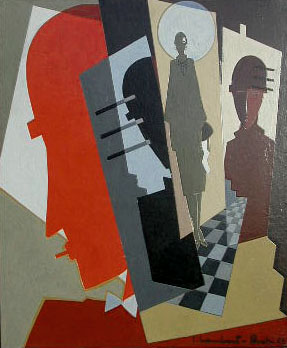Jean Lambert-Rucki
1888 - 1967
Lambert-Rucki was born in Cracow, Poland in 1888. He studied at the
Fine Arts Academy of Cracow before he moved to Paris in 1911. He was
mobilized in World War One, after the war he settled in the Montparnasse
district. He became a naturalized French citizen in 1932.
In Paris he associated with his friend, also born in Cracow, Poland
Moise Kisling, along with Modigliani, Soutine, and the other artists
of Montparnasse. Lambert-Rucki exhibited at the Salon d’Automne
in 1919, he exhibited regularly at the Salon des Indépendants
beginning in 1920, the Salon d’Automne and the Salon des Tuileries
from 1933. He also showed with the Cubists at the Section d’Or
group from 1922 to1924. He exhibited, from 1924, at the gallery of Léonce
Rosenberg, Galerie l‘Effort Moderne.
Lambert-Rucki had been friends with Leopold Survage before the war,
in about 1919 they met again. They both exhibited at Galerie l’Effort
Moderne and the Section d’Or, the similarities in their paintings
are striking. They both used a small shadowy figure in their paintings
for many years. Many people have argued who was the first to do so,
but like Picasso and Broque who painted works that were indistinguishable
from each other’s, it hardly matters.In 1930 Lambert-Rucki was
invited to participate in the first exhibition of l’Union des
Artistes Modernes, where he continued to show his works in subsequent
years.
Lambert-Rucki was represented in the Pavillon de l’Union des Artistes
Moderne at l’Exposition Universalle in Paris in 1937, He executed
many wall sculpture and masks. He also exhibited jewelry designs that
were produced by master jeweler Jean Fouquet, and shown in the Pavillon
de la Lumiére.
Lambert-Rucki was a sculptor and a painter; he achieved his greatest
successes in his collaboration with furniture designer Jean Dunand where
he met in 1923. Lambert-Rucki designs for Dunand’s lacquered furniture
was at the height of the Art Deco movement.
Lambert-Rucki worked in several different styles, he painted Cubist
cityscapes, and many works influenced by the Tribal Art of Africa, his
Cubist and primitive styles translated well into his vast production
of sculpture.
|

